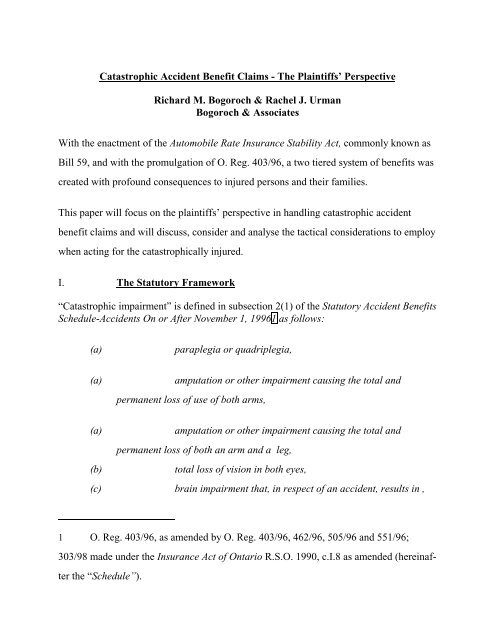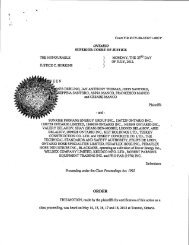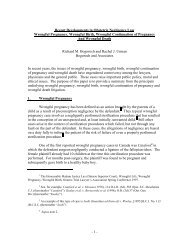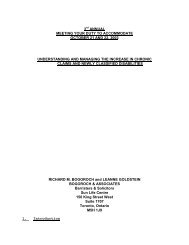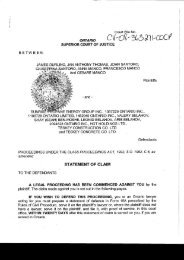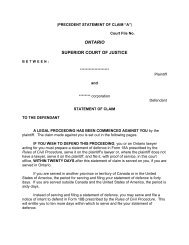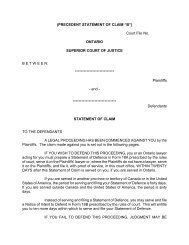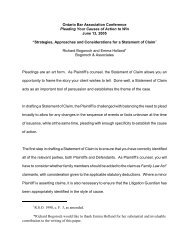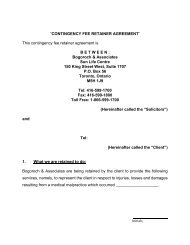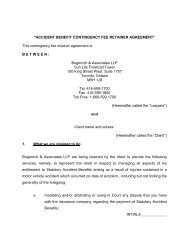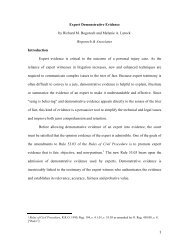Catastrophic Accident Benefit Claims - The Plaintiffs' Perspective
Catastrophic Accident Benefit Claims - The Plaintiffs' Perspective
Catastrophic Accident Benefit Claims - The Plaintiffs' Perspective
Create successful ePaper yourself
Turn your PDF publications into a flip-book with our unique Google optimized e-Paper software.
<strong>Catastrophic</strong> <strong>Accident</strong> <strong>Benefit</strong> <strong>Claims</strong> - <strong>The</strong> Plaintiffs’ <strong>Perspective</strong>Richard M. Bogoroch & Rachel J. UrmanBogoroch & AssociatesWith the enactment of the Automobile Rate Insurance Stability Act, commonly known asBill 59, and with the promulgation of O. Reg. 403/96, a two tiered system of benefits wascreated with profound consequences to injured persons and their families.This paper will focus on the plaintiffs’ perspective in handling catastrophic accidentbenefit claims and will discuss, consider and analyse the tactical considerations to employwhen acting for the catastrophically injured.I. <strong>The</strong> Statutory Framework“<strong>Catastrophic</strong> impairment” is defined in subsection 2(1) of the Statutory <strong>Accident</strong> <strong>Benefit</strong>sSchedule-<strong>Accident</strong>s On or After November 1, 19961 as follows:(a)paraplegia or quadriplegia,(a)amputation or other impairment causing the total andpermanent loss of use of both arms,(a)amputation or other impairment causing the total andpermanent loss of both an arm and a leg,(b)total loss of vision in both eyes,(c) brain impairment that, in respect of an accident, results in ,1 O. Reg. 403/96, as amended by O. Reg. 403/96, 462/96, 505/96 and 551/96;303/98 made under the Insurance Act of Ontario R.S.O. 1990, c.I.8 as amended (hereinafterthe “Schedule”).
a) a score of 9 or less on theGlasgow Coma Scale as published in Jennett, B. andTeasdale G., Management of Head Injuries, ContemporaryNeurology Series, Volume 20, F.A. Davis Company,Philadelphia, 1981, according to a test administered within areasonable period of time after the accident by a persontrained for that purpose, ora) a score of 2 (vegetative) or 3(severe disability) on the Glasgow Outcome Scale, aspublished in Jennett, B. and Bond, M., Assessment ofOutcome After Severe Brain Damage, Lancet i:480, 1975,according to a test administered more than six months afterthe accident by a person trained for that purpose(f)subject to subsections (2) and (3), any impairment or combination ofimpairments that, in accordance with the American Medical Association’sGuides to the Evaluation of Permanent Impairment, 4 th edition, 1993,results in 55 per cent or more impairment of the whole person, or(a)subject to subsections (2) and (3), any impairment that, inaccordance with the American Medical Association’s Guides to the Evaluation ofPermanent Impairment...results in a class 4 impairment (marked impairment) orclass 5 impairment (extreme impairment) due to mental or behaviourial disorderSubsection 2(3) provides that, for the purposes of clauses (f) and (g) of the definition of“catastrophic impairment” in subsection (1), an impairment that is sustained by aninsured person but is not listed in the American Medical Association’s Guides to the
Evaluation of Permanent Impairment2 shall be deemed to be the impairment that is listedin that document and that is most analogous to the impairment sustained by the insuredperson.<strong>The</strong> definition of “catastrophic impairment” creates interpretive difficulty because of itsutilization of both subjective and objective criteria. Clauses (a) through (d) are objectiveand there is little interpretive difficulty. <strong>The</strong>se categories are, however, restrictive and,with respect, unfair. Any amputation of a limb should be considered catastrophic. <strong>The</strong>loss of one or two legs of one arm is catastrophic and, even with the aid of a prostheticdevice, results in a significant, if not total, disruption to an injured person’s life. Yet, thelegislature requires not only that there be an amputation, but that it be a doubleamputation - loss of not only a leg, but both arms or an arm and a leg.Clauses (e) and (f), which involve subjective criteria, are recipes for uncertainty, confusionand litigation. Surprisingly, with the exception of Unifund Assurance Company v.Michael Fletcher3 (discussed in detail below), which was not a court decision, but adecision of a private arbitrator, there have been no cases which have interpreted clauses(e), (f) and (g).II.<strong>The</strong> Legislative Purpose of the Regulatory Framework and<strong>The</strong> Importance of Outcome<strong>The</strong> legislative purpose of the Schedule can best be described as the provision of sufficient benefitsto enable injured persons to obtain the treatment, rehabilitation and non-medical assistancenecessary to carry on day to day and, insofar as possible, reintegrate them into their families,society and the workforce to try and place them in the same position they were in before theaccident. In the case of catastrophically impaired persons, their injuries seriously and2 (4 th ed.) American Medical Association (1995).3 Decision of Bruce R. Robinson, Arbitrator, rendered January 18, 2000 (hereinafter“Unifund v. Fletcher”).
continuously impair their functioning and quality of life, such that enhanced benefits are requiredto enable them to achieve this legislative objective.Further, sub-section 267.5(4) of the Insurance Act also recognizes the enormous costs of rehabilitationand medical care for the catastrophically impaired by permitting such individuals to claimhealth care costs over and above those paid by their no fault accident benefits insurer in the contextof the tort claim.4 In non-catastrophic cases, such claims are not permitted in the tort action.III.Subjective Element in the Assessment of Brain Impairment by Use of theGlasgow Coma ScaleReasonablenessAs noted above, subparagraph 2(1)(e)(i) provides for a determination of catastrophic impairment,by use of the Glasgow Coma Scale (hereinafter “GCS”). <strong>The</strong> GCS is a test comprised of objectivemeasures of verbal, oral, visual and muscular responsiveness, used in the diagnosis of braindamage. Although the GCS is comprised of objective measures, the determination ofcatastrophic impairment through its administration, in subparagraph 2(1)(e)(i) involves at leastone subjective component, namely, the requirement that the GCS be administered “within areasonable period of time after the accident”. <strong>The</strong> obvious question arising, as in any“reasonableness” standard, is what constitutes a “reasonable” period of time. Neither theSchedule nor the Financial Services Commission of Ontario (hereinafter “FSCO”), whichadministers the regulatory scheme set out in the Schedule, provides any directive in this regard.4 Henderson v. Parker (1998), 42 O.R. (3d) 462 (Gen. Div.).
Importance of Timing<strong>The</strong> issue of what constitutes a reasonable period of time was considered in Unifund v. Fletcher,a decision of a private arbitrator. <strong>The</strong> case concerned a 14 year old, Michael Fletcher, who wasinjured in a motor vehicle accident that occurred on September 30, 1997 while riding his bicyclethrough an intersection. <strong>The</strong> ambulance crew responding to the accident took GCS scores at thescene. <strong>The</strong> initial GCS recording was made at 18:57, 14 minutes after the accident. At that time,Mr. Fletcher’s score was 6 out of 15. <strong>The</strong> second score, recorded at 19:02, was 8 out of 15 andthe third, recorded at 19:03, at which time the ambulance arrived at the hospital, was 11 out of15. Sometime thereafter, Mr. Fletcher was transferred to a second hospital. En route, at 21:44,his GCS score was 10 out of 15 and, on admission to the second hospital, his GCS score rose to13 at 23:30 and 14 on 00:30 on October 1, 1997. No further GCS scores were obtained.5Counsel for Mr. Fletcher, in an effort to have his client deemed catastrophically impaired, arguedthat the GCS results of 6 and 8, obtained 14 minutes and 19 minutes after the accident, respectively,should apply on the basis that the GCS evaluations were conducted within a reasonableperiod of time following the accident. Indeed, the report prepared by the Designated AssessmentCentre (hereinafter “DAC”) came to the same conclusion.<strong>The</strong> arbitrator, however, adopted the approach of the insurer and its expert, neurologist, Dr.Bruce M. Stewart. Dr. Stewart testified that the standard rule of medical practitioners is that 30minutes is a reasonable time within which to recover to a normal GCS. He further testified that,while the creator of the GCS, Dr. Jennett, did not comment on timing when developing the scale,a neurologist or neurosurgeon would view a “reasonable time” for assessment of the patient’scondition and making a prognosis as six hours at a minimum.6 Finally, Dr. Stewart concludedthat, in the Fletcher case, the insured’s actual GCS score, which rose from 6 (14 minutes postaccident)to 11 (20 minutes after the accident) and did not drop below 9 at any time thereafter, isinconsistent with a catastrophic brain injury.7It is worth noting that the arbitrator was critical of the DAC assessor’s decision to impose hisown definition of “a reasonable period of time after the accident” (ignoring the score of 11 at19:03) rather than accepting the judgment of the clinicians administering the GCS. This, he held,was inconsistent with the erratum issued by the Minister’s Committee in June of 1998, which5 Ibid at pp.2-36 Ibid., at pp.6-7.7 Ibid., at p.9.
specifies that DAC Committees are not permitted to provide their own definition of what constitutes“a reasonable period of time”.<strong>The</strong> Unifund v. Fletcher case, although interesting and informative, does not command the samedeference that a court or arbitral decision of the Financial Services Commission would. As such,this issue is far from resolved and subsequent decisions will need to address whether Mr. Robinson’sanalysis is correct.I. Determination of <strong>Catastrophic</strong> Impairment - Procedural RequirementsInsurer’s Determination of <strong>Catastrophic</strong> ImpairmentPursuant to subsection 40(1), an insured person may apply to the insurer for a determination ofwhether the impairment is a catastrophic impairment as defined in the Schedule. After receivingthe application, the insurer has 30 days to do one of thefollowing:(a) determine that the impairment is catastrophic and give the insured person notice of the determination;(b) determine that the impairment is not catastrophic and give the insured person notice of thedetermination, including the reasons for the determination; or(c)give the insured person notice that the insurer requires the insured person to be assessed by adesignated assessment centre.8It is clear from the wording of subsection 40(1) that the onus is on the insured to apply for adetermination as to whether the impairment is catastrophic and counsel must so advise. In casesof injuries falling into the categories set out in clauses 2(1)(a)-(d), this step will generally be amere formality. <strong>The</strong> opposite is true where evaluation of the injuries is more complex and8 <strong>The</strong> details of the assessment process are set out in s.43 and apply equally to thedetermination of a non-catastrophic impairment.
involves a subjective component, for example, injuries falling into the categories set out inclauses 2(1)(e)- (g). In these latter cases, a catastrophic DAC will be conducted, at the request ofeither the insurer or the injured person.9As has been pointed out,10 in the case of injuries falling within the category set out in clause2(1)(f), it is essential that the client be fully briefed with respect to the nature of the DAC assessmentand the importance of reporting all injuries and limitations to the assessor, regardless oftheir significance to the injured person. If the client fails to do so,he or she may not meet the 55% “whole-body impairment” even though his or her injuries trulyjustify the finding of such impairment.In all cases where a catastrophic DAC has been conducted, counsel for the injured person shouldcarefully review the report of the DAC assessor to determine whether anything was overlooked.Further, counsel should obtain an expert addendum to the DAC report, if necessary. <strong>The</strong>determination of the DAC is not the final answer. Any party may mediate, then arbitrate orlitigate this issue.<strong>The</strong> complexity in determinations of catastrophic impairment under paragraph 2(1)(e), (f) and(g), and the scope for plaintiffs’ counsel to argue for or against a given medical assessment, isevident from the Glasgow Outcome Scale’s five page article on head injury evaluation and thefact that the AMA Guide attempts to list every possible impairment an injured person may have,with an associated percentage rating of “whole-body impairment”.11 In the latter case, eachpercentage is combined according to a set of tables to determine the percentage of whole-bodyimpairment that the person has sustained. It is important that all counsel dealing with seriousinjuries understand the list of impairments and calculation tables in the AMA Guide.9 See subparagraph 40(2)(c), subsection 40(3) and section 43 of the Schedule.10 See Howie and Wagman, “How Bill 59 Will Impact Plaintiffs and <strong>The</strong>ir Counsel in theManagement of <strong>The</strong>ir <strong>Claims</strong>” <strong>The</strong> Canadian Institute Conference re: Bill 59 (March 20 & 21,1997).11 Supra note 2.
Catalogue of <strong>Benefit</strong>s for <strong>Catastrophic</strong> Impairment -Neutralizing the DAC Assessment.As previously mentioned, the determination of the “DAC” as to whether or not an injury orimpairment is catastrophic is not final. Each insured person has the right to arbitrate or litigatehis dispute with the insurer. Counsel must retain a suitably qualified expert to review, considerand analyze the report of the DAC and to provide a critique and criticism of the methodologyemployed and the findings reached. <strong>The</strong> issue in Unifund v. Fletcher as to what constitutes “areasonable period of time” is as much more a legal issue than a medical issue. <strong>The</strong> neurologists,neurosurgeons and other experts may disagree, but it will be up to a judge or an arbitrator todetermine what is reasonable. One can anticipate that there will be divergence of opinionsbetween judges and arbitrators and, ultimately, it may be for the Court of Appeal to resolve thiscontroversy.Realistically, whether there is $100,000.00 or $1,000,000.00 of medical/rehabilitation fundingavailable may not be always of practical significance. If the injured person does not haveongoing medical and rehabilitation needs beyond the $100,000.00 limit, whether the claim is oris not catastrophic may not change anything. However, if the injured person suffers from chronicpain, fibromyalgia, or from mild or moderate brain injury, one could anticipate the need forongoing medical and rehabilitation care needs which normally would exceed the $100,000.00limit.Consider this example. Smith, is injured in a car accident in which his car was broad sided by atractor trailer. Smith was not wearing a seatbelt and he struck his head on the windshield. Smithsuffered a loss of consciousness and his Glasgow Coma Scale score was 7 out of 15. One hourlater at the hospital it was 15 out of 15. Is this claim catastrophic? As a result of the accident,Smith is no longer able to work. He suffers from memory loss, depression, personality change,irritability, anxiety, poor concentration, nightmares and has developed a phobic reaction such thathe cannot be with people or in cars. One can easily anticipate that he would require in excess of
$100,000.00 in medical/rehabilitation services. He will require the services of a psychologist,social worker, vocational counselor, job coach, occupational therapist, chiropractor, messagetherapist, acupuncturist and physiotherapist.Assume that the $100,000.00 limit will be exhausted in less than 3 years. Are Mr. Smith’simpairments considered catastrophic? Much depends on what the term “reasonable means”.Cases like this will have to be litigated and guidelines set by the courts to fill in the gaps createdby the regulations in order to help resolve these interpretational difficulties. Smith’s impairmentscould be considered catastrophic either because his GCS was below 9 within a “reasonableperiod of time” or because his impairments constitute a 55% impairment of the whole personwithin the meaning of Section 2(1)(f) of the Schedule.<strong>The</strong>se cases will be expensive to litigate, but it is absolutely critical that counsel for the injuredvictim must be able to marshal on his or her client’s behalf, pertinent, credible and compellingexpert evidence.V. <strong>The</strong> “Catch All” 55% Impairment of the Whole-Person<strong>The</strong> American Medical Association’s Guide to Permanent Impairment sets out a difficult test forpermanent impairment. Few people understand what is required. Indeed the guide to PermanentImpairment is not a guide, but a lengthy book inwhich every human activity is weighed, analyzed and considered. Every activity is carved upinto discrete percentages.For example, does a person suffering from a mild brain injury, chronic pain, fibromyalgia, orpost- traumatic stress disorder suffer a catastrophic impairment? Much depends on whether theperson is capable of carrying on a normal life. It will be extremely difficult to persuade any trierof fact that a person suffering from impairments common to chronic pain or fibromyalgia meetsthe rigorous and restrictive test found in the American Medical Association’s Guides to theEvaluation of Permanent Impairment. However, there will be cases where the extent of thedepression, post- traumatic stress, or pain is so disabling and debilitating as to constitute a total
disruption of the person’s life, that he or she may qualify under this heading. <strong>The</strong> effect on theactivities of daily living, self care, personal hygiene, communication, travel, sexual function,sleep and social recreational activities are so profound and limiting that the impairments couldvery well constitute a 55% impairment of the whole person.12 <strong>The</strong>re will be few cases that meetthis requirement.12 Chapter 14: “ Mental and Behavioral Disorder” to the American Medical Association’sGuides to the Evaluation of Permanent Impairment, supra note 2.
I. Cashing-Out <strong>Catastrophic</strong> <strong>Claims</strong>In previous articles13 , Richard Bogoroch has written about some of the considerationsinvolved in negotiating “cash-outs” of statutory accident benefit claims. <strong>Catastrophic</strong>claims present a host of difficulties in this regard. While the claims are substantial,different considerations apply. Timing and the discount rate to employ are among themost important factors to consider. Counsel would be doing his or her client a disserviceif the claim is cashed-out too soon after the initial injury, or if too great a discount topresent value is accorded to the insurer.TimingIn the early stages of catastrophic injury, the insurer generally devotes a great deal of time,resources and energy to properly adjust the claim.14 Adjusting techniques mean not onlyreviewing the claim and arranging for medical assessments, but ensuring that capable,experienced claims personnel are placed on the file.15 A Case Manager is retained andcoordination of medical and rehabilitation treatment is planned, organized and implemented.<strong>The</strong> insured person, in the early stages, is provided with a panoply of services generally fromhighly qualified service providers. It would be a mistake obviously, at this stage, to evencontemplate a “cash-out”. As your client’s condition stabilizes, or if it is determined that nofurther improvement is contemplated, it is reasonable to start considering a “cash-out” ofbenefits.13 R. M. Bogoroch, “Cashing Out <strong>Accident</strong> <strong>Benefit</strong>s <strong>Claims</strong> Under the Statutory <strong>Accident</strong><strong>Benefit</strong>s Schedule” <strong>The</strong> Law Society of Upper Canada Conference on Personal Injury Litigation(June 11, 1997); and14 See also in this regard, Joseph J. Sullivan’s comments in his paper, “<strong>The</strong> Defence<strong>Perspective</strong>.”15 See Sullivan, supra.
Prior to negotiating a “cash-out” you should do the following:0. Obtain copies of the complete file to ensure that your brief is similar to theinsurers’;2. Retain a highly qualified occupational therapist or other experienced experts toprepare a future care cost report outlining the goods and services that your client willrequire. See Appendix “A” for a sample report;1. Obtain a list from the insurer of all the benefits paid to date to know how much ofthe policy limit remains;1. Retain an actuary or chartered accountant and calculate the present value of thefuture care costs as well as the income replacement benefits to which your client isentitled; and1. Ensure that you are in receipt of a report regarding your client’s life expectancy.Persons with catastrophic impairments, not always, but frequently, have reduced life expectancies.It is essential if you are going to negotiate settlement of your client’s claim that you knowwhat his or her life expectancy is. Invariably, the insurer will have a report with the most pessimisticview of your client’s life expectancy. That report must be reviewed, analyzed andcritiqued by an expert of your choosing. You should never accept the insurer’s opinion of lifeexpectancy without having that opinion vetted by your own expert.How Much Discount is Appropriate in a <strong>Catastrophic</strong> Case?<strong>The</strong> insurer is not required to “cash-out” benefits. <strong>The</strong>y are required to adjust the case and to paybenefits to its insured in accordance with the Schedule and the arbitral and court decisions whichhave interpreted the Schedule. A “cash-out” or “lump-out” is a monetization of its contractual
obligations under the Schedule and is of tremendous benefit to the injured person. <strong>The</strong> insurer,therefore, quite properly seeks a discount from the net present value of the injured person’s entitlement.<strong>The</strong> discounts should not be significant. <strong>The</strong> catastrophically injured person requiresthe money for life. He or she will also require continuous and regular medical and rehabilitationand attendant care. A 25% discount is more than reasonable. A discount of more than 25%under the circumstances, may not be in the best interest of the injured person. <strong>The</strong> “cash-out”,therefore, may not be in your client’s best interest. If the discount sought is too significant do not“cash- out”.<strong>The</strong> Advantages to Cashing OutMost clients wish to be free of the overarching supervision and direction of the insurer. <strong>The</strong>ywant the insurer out of their lives. <strong>The</strong>y want to be free to control their medical treatment andrehabilitation without having to seek permission for funding approval from the insurer andwithout having to constantly seek reimbursement for any and all expenses. <strong>The</strong>re arepsychological and very real advantages to terminating the relationship between the insured andthe insurer. As indicated above, if the price is too high it is not worth it. Nonetheless if clientswish to embark on “cash- outs” after making fully informed decisions and considering carefullythe advantages and disadvantages of “cashing-out”, counsel must abide by his or her client’sinstructions. I have attached a sample form, as Appendix “B”, which I trust will provide counselwith assistance.VII.Representing the Mentally Incapable ClientPracticing law in the millennium is difficult, often times complex and always challenging. Representingpersons under disability creates a host of difficulties for even the most experienced counsel.Mentally incapable clients must have a guardian appointed pursuant to the SubstituteDecisions Act16. Even if no such guardian is appointed, any settlement must be court approved16 S.O. 1992, c.30, as amended.
pursuant to Section 7of the Rules of Civil Procedure. Court approval documentation should beexplicit, detailed and should also contain a clear description of the fees proposed to be charged asthe court must approve the client’s account. This protection is not just for the benefit of theclient, but for the benefit of the insurer as well. Any settlement not so approved is open to beattacked and set aside if it is determined that the insured person lacked capacity to instructcounsel.I. Reversionary InterestsOne of the interesting features of “cashing-out” benefits is the use of reversions in structured settlements.<strong>The</strong> reversion simply provides that, if the insured person does not live beyond a certainperiod of time, the structure reverts to the insurer.For the longest time some of us have had an aversion to reversions. We simply would not settlea case if the insurers sought a reversionary interest. Because we have utilized “cash-outs” as away to monetize settlements and to provide for the injured person’s family in the event of his orher demise, there is something jarring about giving that money back to the insurer in the event ofdeath. In theory, however, there should be no such theoretical obstacle. If the purpose of the“cash-out” is to provide for the future care, future medical and future income needs and if thoserequirements need not be funded because of the death of the insured, there is nothing wrong inprincipal with the funds reverting back to the insurer. However, everything is a question of negotiation.Much depends on the “cards” you have drawn, the nature of the case, the factsunderlying the case and the way the insurer has behaved from the inception of the file. All ofthese are the levers to be utilized in the negotiation with the insurer.<strong>The</strong>re are numerous combinations and permutations to employ. Reversions can be granted foronly a portion of the principal amount of the settlement, or you can share in the reversion withthe insurer. If the insured dies within the guaranteed period, half the money or a quarter of the
money, or whatever percentage you arrive at would then revert back to the insurer. As statedearlier, much depends on negotiation.I. ConclusionIn the years to come, case law and arbitral decisions will, we expect, resolve some of theinterpretive difficulties arising from the definition of a catastrophic impairment. Few cases willpresent much difficulty. For those that do, it is hoped that this paper will shed some light on adifficult and complex task, will enable counsel who represent the catastrophically injured to havea better understanding of the issues involved in catastrophic impairments, and to illuminate someof the tactics and considerations involved in negotiating “cash-outs”.


